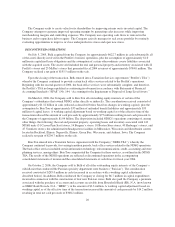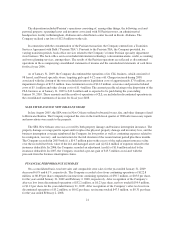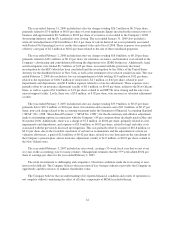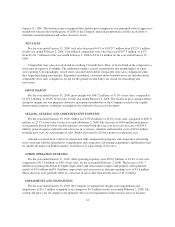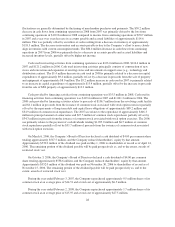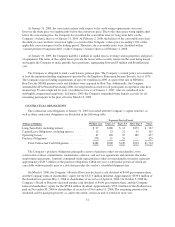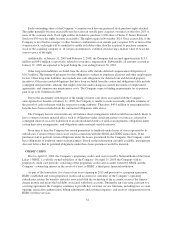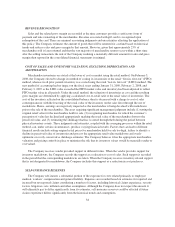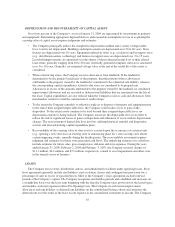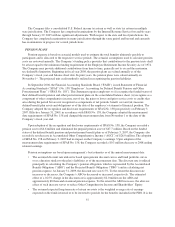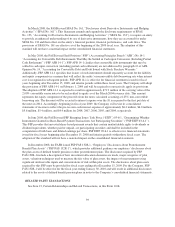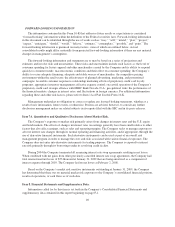Saks Fifth Avenue 2008 Annual Report Download - page 31
Download and view the complete annual report
Please find page 31 of the 2008 Saks Fifth Avenue annual report below. You can navigate through the pages in the report by either clicking on the pages listed below, or by using the keyword search tool below to find specific information within the annual report.prescribed percentage of eligible inventories and receivables. There are no debt ratings-based provisions in the
revolving credit facility. The facility includes a fixed-charge coverage ratio requirement of 1 to 1 that the
Company is subject to only if availability under the facility becomes less than $60 million. At January 31, 2009,
the Company’s fixed charge coverage was below the 1 to 1 requirement; however, the Company is not subject to
the fixed charge coverage ratio as its availability under the facility exceeds $60 million. The facility contains
default provisions that are typical for this type of financing, including a provision that would trigger a default of
the facility if a default were to occur in another debt instrument resulting in the acceleration of principal of more
than $20 million in that other instrument. At January 31, 2009, the Company had $156.7 million in borrowings
under the revolving credit facility. The senior revolving credit facility has a maximum capacity of $500 million.
The Company plans to reduce its inventory levels in 2009, and consequently, the maximum availability is
expected to be below $500 million in certain periods during 2009.
At January 31, 2009, the Company had $192.3 million of senior notes outstanding, excluding the convertible
notes, comprising four separate series having maturities ranging from 2010 to 2019 and interest rates ranging
from 7.00% to 9.88%. The terms of each senior note call for all principal to be repaid at maturity. The senior
notes have substantially identical terms except for the maturity dates and interest rates payable to investors. Each
senior note contains limitations on the amount of secured indebtedness the Company may incur. The Company
believes it will have sufficient cash on hand, availability under its revolving credit facility and access to various
capital markets to repay these notes at maturity.
On April 12, 2007, the Company announced the results of its modified “Dutch Auction” tender offer to
purchase a portion of its 8.25% senior notes due November 15, 2008 for an aggregate purchase price not to
exceed $100 million (the “offer cap”). The offer expired on April 11, 2007. The aggregate principal amount of
notes validly tendered at or above the clearing spread exceeded the offer cap and the Company accepted $95.9
million aggregate principal amount of the notes, resulting in an aggregate purchase price of $100 million (plus an
additional $3.2 million in aggregate accrued interest on such notes). The Company accepted for purchase first, all
notes tendered at spreads above the clearing spread, and thereafter, the notes validly tendered at the clearing
spread on a prorated basis according to the principal amount of such notes. During the three months ended
May 5, 2007, the Company recorded a loss on extinguishment of approximately $5.2 million related to the
repurchase of the notes.
During June and July 2007, the Company repurchased an additional $10.4 million in principal amount
primarily relating to its 8.25% senior notes. The repurchase of these notes resulted in a loss on extinguishment of
approximately $412 thousand. The remainder of the 8.25% notes were retired upon maturity on November 15,
2008.
The Company had $230 million of convertible senior notes, at January 31, 2009, that bear interest of 2.0%
and mature in 2024. The provisions of the convertible notes allow the holder to convert the notes to shares of the
Company’s common stock at a conversion rate of 83.5609 shares per one thousand dollars in principal amount of
notes. The most significant terms and conditions of the senior notes include: the Company can settle a conversion
with shares and/or cash; the holder may put the debt back to the Company in 2014 or 2019; the holder cannot
convert until the Company’s share price is greater than 120% of the applicable conversion price for a certain
trading period; the Company can call the debt on or after March 11, 2011; the conversion rate is subject to a
dilution adjustment; and the holder can convert upon a significant credit rating decline and upon a call. The
Company used approximately $25 million of the proceeds from the issuances to enter into a convertible note
hedge and written call options on its common stock to reduce the exposure to dilution from the conversion of the
notes. The Company believes it will have sufficient cash on hand, availability under its revolving credit facility
and access to various capital markets to repay both the senior notes and convertible notes at maturity.
30


